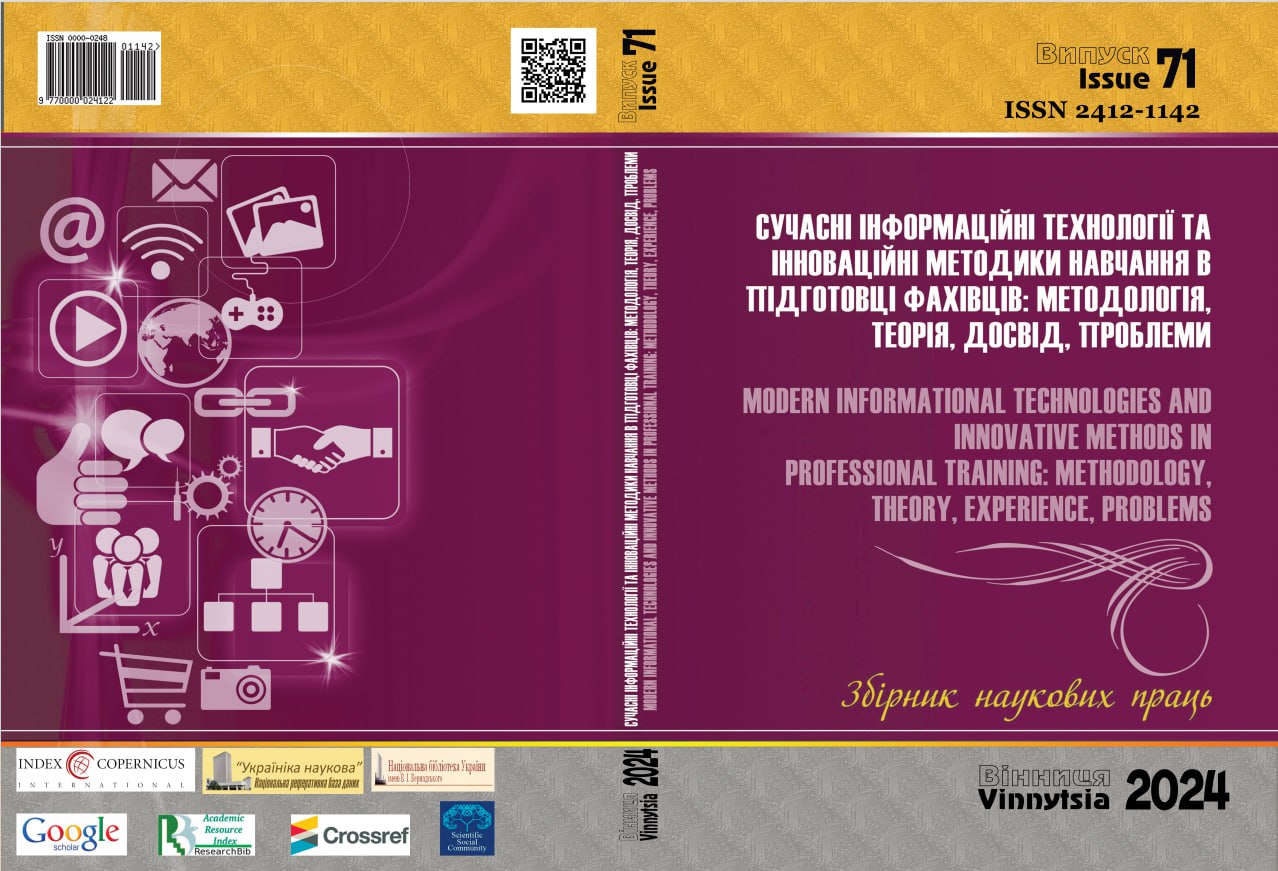BUILDING AN INDIVIDUAL CURRICULUM FOR THE IMPLEMENTATION OF AN INDIVIDUAL EDUCATIONAL TRAJECTORY
DOI:
https://doi.org/10.31652/Keywords:
individual training plan; individual educational trajectory; individual training; inclusive educationAbstract
The article considers the problem of the realization of individual educational trajectories. The development and support of these trajectories are implemented through an asynchronous training format and are becoming increasingly popular. That makes it possible to build your career independently in the future. At the same time, scientists note that young people often face the problems like a lack of formed skills in independent learning activities, setting achievable goals, the ability to choose methods, forms, and means of teaching, and the ability to reflect on personal achievements and take responsibility for decisions made. Therefore, the study goal is the detail the unique curriculum construction through the particular educational trajectory implementation. The theoretical methods of scientific research (analysis to clarify the research thesaurus, and content analysis to detail the building of the individual training plan to implement a unique educational trajectory were used to achieve the goal. The fragmentary nature of scientific results, explaining the building of a unique curriculum, is stated. The authors describe the concept of an individual plan and emphasize the ability of teachers to set achievable goals. The article provides generalized recommendations for correct goal setting in building an individual curriculum and advises creating a particular educational trajectory. The features of individual curriculum building and the individual educational trajectory implementation are detailed. The concept of SMART goals (specific, measurable, consistent, relevant, and limited in time) has been clarified. Authors emphasize that SMART goals should include observable measures, a balanced time frame for their achievement, and criteria for measuring student achievements. In conclusion, the authors recommend following the idea of individualized learning, which will contribute to the formation of skills of independent activity, as well as awareness of learning goals, increasing responsibility for their learning, and development of selfconfidence through an understanding of strengths and weaknesses.
Downloads
References
Амонашвілі, Ш.А. (2017). Педагогічні притчі: виховання серцем. Х: Видавничий дім «ШКОЛА».
Мірошник, З. М. (2009). Психологічна характеристика соціальної ролі у структурі особистості сучасного вчителя. Педагогічна наука: історія, теорія, практика, тенденції розвитку, 4. URL: http://www.intellectinvest.org.ua/pedagog_editions_e-magazine_pedagogical_science_arhiv_pn_n4_2009_st_5.
Качуровський, М.О. (2010). Філософія освіти: навчально-методичний посібник. Суми: СумДПУ ім. А.С. Макаренка.
Руденко, Ю. (2013). Роль особистісно орієнтованого навчання в процесі формування готовності до особистісного самовизначення майбутнього соціального педагога. Наукові записки Кіровоградського державного педагогічного університету імені Володимира Винниченка. Серія : Педагогічні науки, 120, 286-292.
Зязюн, І. А. (2009). Творчий потенціал особистості вчителя: психолого-педагогічні орієнтири. Професійна освіта: ціннісні орієнтири сучасності (Збірник наукових праць), 1, 11-22.
Rudenko, Y., Drushlyak, M., Osmuk, N., Shvets, O., Kolyshkin, O., & Semenikhina, O. (2022). Problems of Teaching Pupils of Non-Specialized Classes to Program and Ways to Overcome Them: Local Study. International journal of computer science and network security, 22, 1, 105-112. https://doi.org/10.22937/IJCSNS.2022.22.1.16.
Семеніхіна, О.В., & Руденко, Ю.О. (2018). Проблеми навчання програмувати учнів старших класів та шляхи їх подолання. Інформаційні технології і засоби навчання, 66(4), 54-64.
Semenikhina, O.V., Drushlyak, M.G., Bondarenko, Yu.A., Kondratiuk, S.M., & Ionova, I.M. (2019). Open Educational Resources as a Trend of Modern Education. 42nd International Convention on Computers in Education (MIPRO) (May 20-24, 2019). Opatija, Croatia, 779-782.
Rudenko, Yu., Naboka, O., Korolova, L., Kozhukhova, K., Kazakevych, O., & Semenikhina, O. (2021). Online Learning with the Eyes of Teachers and Students in Educational Institutions of Ukraine. TEM Journal, 10(2), 922‐931. https://doi.org/10.18421/TEM102-55.
Drushlyak, M., Semenikhina, O., Proshkin, V., & Naboka, O. (2020). Use Of Specialized Software For The Development Of Visual Thinking Of Students And Pupils. Innovative Educational Technologies, Tools, and Methods for E-learning. Scientific Editor Eugenia Smyrnova-Trybulska “E-learning”, 12, Katowice–Cieszyn, 147–158. https://doi.org/10.34916/el.2020.12.13.
Rudenko, Yu., Naboka, O., Petrenko, S., Ostroha, M., Pronikova, M., & Semenikhina, O. (2022). Using Web Quests in Professional Training Student-Managers. 45th International Convention on Information, Communication and Electronic Technology, MIPRO 2022 – Proceedings, 770-775. https://doi.org/10.23919/MIPRO55190.2022.9803400.
Мулеса, П., & Семеніхіна, О. (2021). Соціальні мережі як цифровий інструмент професійної діяльності вчителя. Вісник Національного університету «Чернігівський колегіум» імені Т. Г.Шевченка, Педагогічні науки, 14–15, 145-150.
Pérez-Tornero, J. M., & Tayie, S. (2012). Teacher training in media education: curriculum and international experiences. Comunicar, 20(39), 10-14. https://doi.org/10.3916/C39-2012-02-00.
Rudenko, Yu., Semenikhina, О., Kharchenko, І., & Kharchenko, S. (2021). Distance Learning: Results Of A Survey Of Teachers And College Students. Information Technologies and Learning Tools, 86(6), 313–333.
Юрченко, А.О., Семеніхіна, О.В., Хворостіна, Ю.В., & Удовиченко, О.М. (2019). Навчання програмувати в старшій школі крізь призму чинних навчальних програм. Фізико-математична освіта, 2(20), 2, 47-54.
Voitenko, A., & Semenikhina, O. (2019). To the question about inclusive educational space in the training of informatics of children with intellectual disabilities. Education. Innovation. Practice, 2(6), 6-9.
Семеніхіна, О. В., & Друшляк, М. Г. (2022). Типологія цифрових технологій інклюзивного освітнього простору. Фізико-математична освіта, 35(3), 65-70. https://doi.org/10.31110/2413-1571-2022-035-3-009.
Jeong, S., Cho, H., & Hwang, Y. (2012). Media Literacy Interventions: A Meta-Analytic Review. Journal of Communication, 62(3). https://doi.org/10.1111/j.1460-2466.2012.01643.x.
Grimes, D. R. (2020). Health disinformation & social media The crucial role of information hygiene in mitigating conspiracy theory and infodemics. Embo Reports, 21(11), 5181. https://doi.org/10.15252/embr.202051819.
Garro-Rojas, L. (2020). Media Literacy in Latin America: Issues and Experiences. Revista Educación, 44(1), 520-532.
Chetty-Mhlanga, Sh., Fuhrimann, S., & Eeftens M. (2020). Different aspects of electronic media use, symptoms and neurocognitive outcomes of children and adolescents in the rural Western Cape region of South Africa. Environmental Research, 184, 109315.
Semenikhina, O., Yurchenko, A., Sbruieva, A., Kuzminskyi, A., Kuchai, O., & Bida, O. (2020). The Open Digital Educational Resources In IT-Technologies: Quantity Analysis. Information technologies and learning tools, 75(1), 331-348. https://doi.org/10.33407/itlt.v75i1.3114.
Downloads
Published
Issue
Section
License
Copyright (c) 2024 Юрченко Артем Олександрович, Острога Марія Михайлівна, Козолуп Олександр Олександрович

This work is licensed under a Creative Commons Attribution 4.0 International License.





